Lycianthes rantonnetii Is the Botanical name for this lovely Blue shrub or climber. It has blue/purple flowers with a yellow centre and flowers appear in masses in the warmer months. It is suited for temperate and warm climates, and grows best in a sunny position. The growth habit can be variable.... if trimmed regularly, it can retain a bushy habit, but if allowed to go wild it will be more a climber and scramble over a trellis or fence. Don't be tricked by it's name, it does not grow Potatoes , and the plant is poisonous. i took these photos in a garden in Northern Sydney.
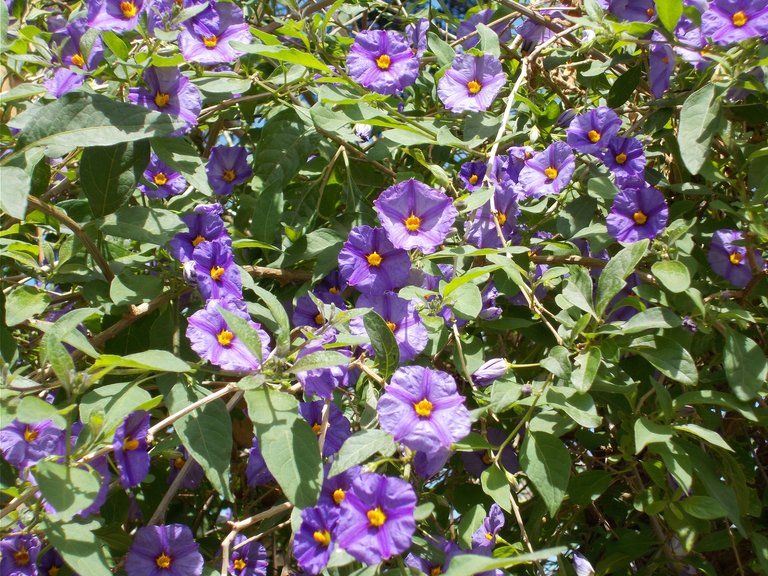

(The Proper Latin Name Is Lycianthes rantonnetii)
Native to Argentina, Bolivia, Brazil, and Paraguay, the blue potato bush is cultivated all over the world for its beautiful deep purple-blue flowers. If you’ve ever seen it bloom, you won’t forget it. The Royal Horticultural Society gave Lycianthes rantonnetii their prestigious Award of Garden Merit in 2012.
The blue potato bush is a fast growing evergreen that will grow to as much as ten feet in height and width. Typically they are pruned back to a much smaller size. They can be pruned to almost any shape and are often trimmed to a round shape with the lower foliage clipped, thus resembling a small tree.
Several cultivars have been produced with different colored foliage and blossoms. The cultivar Lycianthes rantonnetii 'White' has beautiful snow white flowers,
Lycianthes rantonnetii 'White'
while Lycianthes rantonnetii ‘Variegata’ has cream and grey-green leaves with blue flowers.
Lycianthes rantonnetii ‘Variegata’
All varieties are sweetly scented and attract butterflies. If not pruned, this species will also produce berries which will attract a variety of birds.
Resources
Fav. comment Award !! I like the variegated one in the last Pic.
Although this plant is called "Blue Potato Bush", and it is botanically related to edible potatoes, it is grown for its ornamental beauty only. No part of this plant should be consumed. Blue Potato Bush produces an abundance of charming blue flowers over a long season. It's very showy, fragrant, easy to grow, and a magnet for bees and hummingbirds!
Choose a location that will allow roots to spread and branches to grow freely. Space plants far enough from building foundations, walls, and decks so that the growing foliage won't crowd the structure. Consider whether tall trees or shrubs will block windows or interfere with the roof or power lines.
To prepare the planting area dig a hole as deep as the root ball and three times as wide. After removing the soil, mix it with some compost or peat moss. This enriches the soil and loosens the existing dirt so that new roots can spread easily.
To remove the plant from the container, gently brace the base of the plant, tip it sideways and tap the outside of the pot to loosen. Rotate the container and continue to tap, loosening the soil until the plant pulls smoothly from the pot. The container can also be removed by carefully cutting it down the side.
Source: https://www.mygardenlife.com/plant-library/2580/lycianthes/rantonnetii
Source
Lycianthes rantonnetii is a species of flowering shrub in the family Solanaceae. Cultivated as ornamental the world over, you might deem it boring and decide to pass it over. But you'd be wrong.
The blue potato bush is one of about 150 species in the genus Lycianthes, which are found mostly in tropical regions of the Americas, with others in the Asia-Pacific region.
Source
The species is named after Barthélémy Victor Rantonnet, a 19th-century French horticulturalist, who thought at first that it should be lumped in with the nightshades (Solanum) - the same genus as potatoes, hence the frumpy common name: Blue Potato Bush
Source
You can train it into a little tree, or let it be shrubby. It's easy to prune an doesn't care much when you do it. The flowers don't have a scent but aside from that it's a great little plant that handles all sorts of abuse cheerfully.
Source
Source
Oh, and boring? More like dangerous. Like most nightshades all parts of this plant are poisonous so keep your kids and dogs out of the flower beds people. A source of psychoactive alkaloids, they will cause a nasty upset stomach and worse.
Text Source
@ctrl-alt-nwo,
The flower looks beautiful, and the name of the plant also good! But danger is behind it! Really useful article and photography! Actually I didn't know that! It's better we should not grow it at our gardens!
Cheers~
In our country, this plant is called Nightshade Rantonneti. The indisputable advantage of this plant is a bright, long-lasting and abundant flowering. A fast-growing perennial evergreen shrub or small tree up to 3 m tall. The flowers are bright, purple with a yellow center. It blooms very much in summer and in autumn.
It grows very quickly, so you have to pinch and trim it several times a season. But it perfectly tolerates pruning, and thanks to this property, it can be grown as a head tree, and as a lush bush, and even as an ampelous plant. Its young branches are very flexible, easily bend and the plant can be given any desired shape.
http://edenland.com.ua/rasteniya/paslen-rantonneti.html
I like the standard lollipop plant in the first Pic !
Thank you so much
Lycianthes rantonnetii
The potato bush plant is an attractive shrub that grows up to 6 feet tall and wide. It is evergreen in warm climates, and its dense growth habit makes it suitable for use as a hedge or screen. You can also grow it as a tree by removing the lower branches. Pinching the tips of new growth encourages bushiness.

A member of the Solanum family, it is closely related to potatoes, tomatoes and eggplants, but you should never eat it because it is poisonous. Common names for this plant include blue potato bush, Paraguay nightshade and blue solanum shrub.
Potato bush plant is grown outdoors in warm climates. In areas with cool winters, grow it as a potted plant that can be brought indoors when frost threatens. In cool areas, an abundance of small, blue flowers bloom in summer and fall. In frost-free areas, it blooms year round. The flowers are followed by bright red berries.
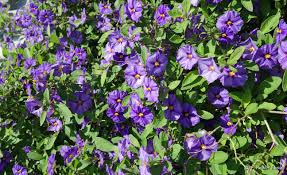
Source
1234
Very attractive flowers but they are poisonous. I quite like them in a big bush. My bandwidth is back to normal. So good to be able to vote and comment again.
Posted using Partiko iOS
It looks beautiful when carefully trimmed and arranged @ctrl-alt-nwo as the purple flowers really is nice to look at.
The potato bush plant is an attractive shrub that grows up to 6 feet tall and wide. It is evergreen in warm climates, and its dense growth habit makes it suitable for use as a hedge or screen. You can also grow it as a tree by removing the lower branches. Pinching the tips.
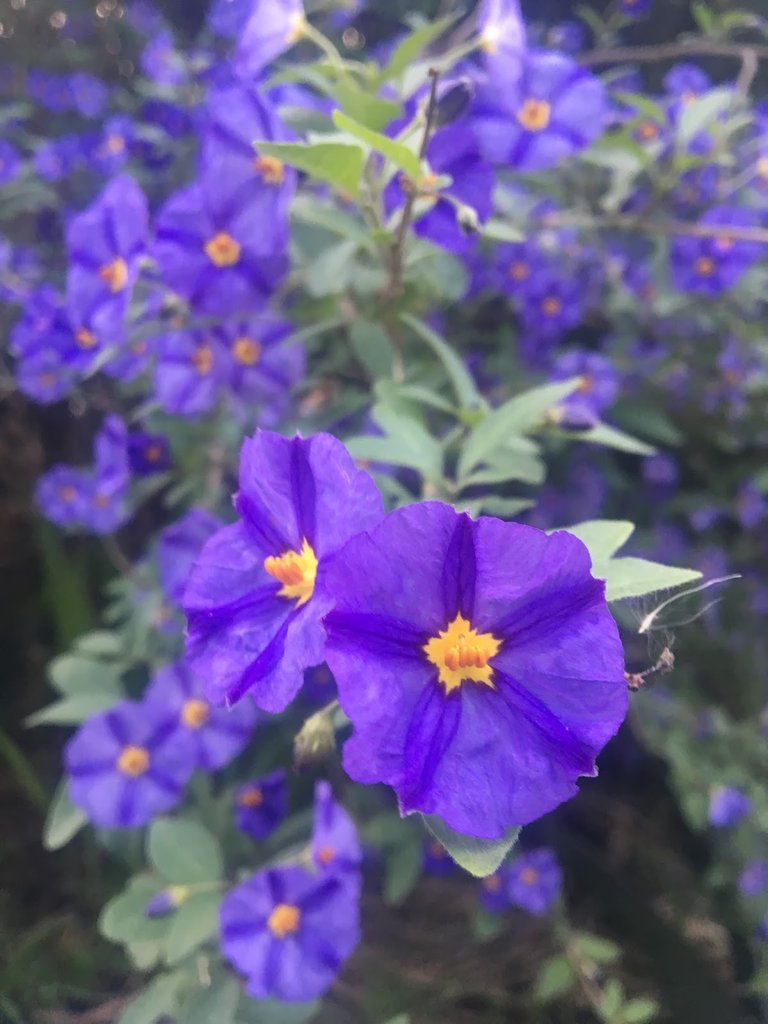
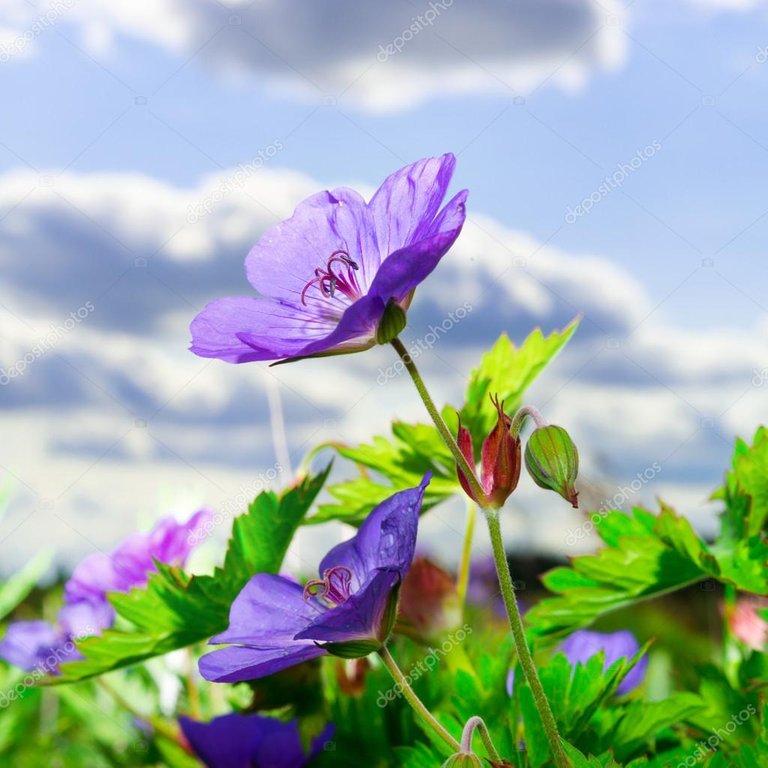
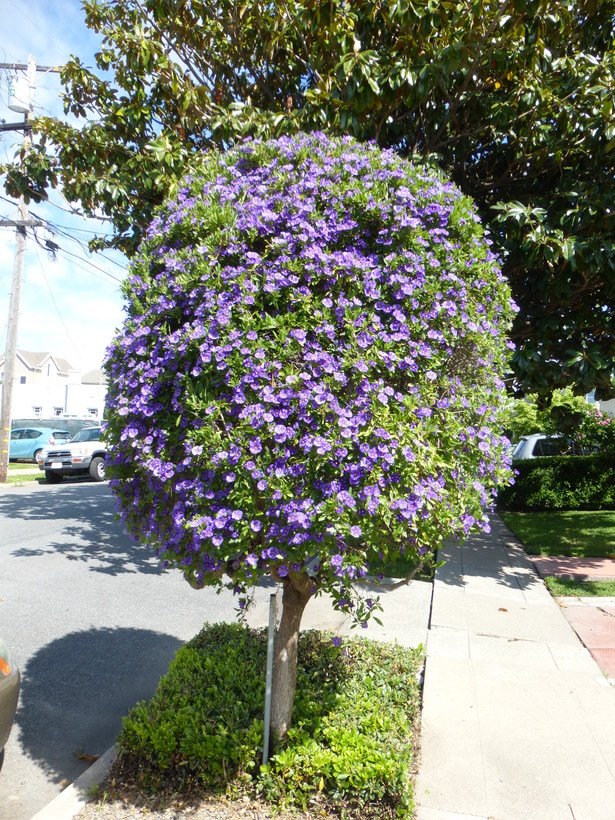
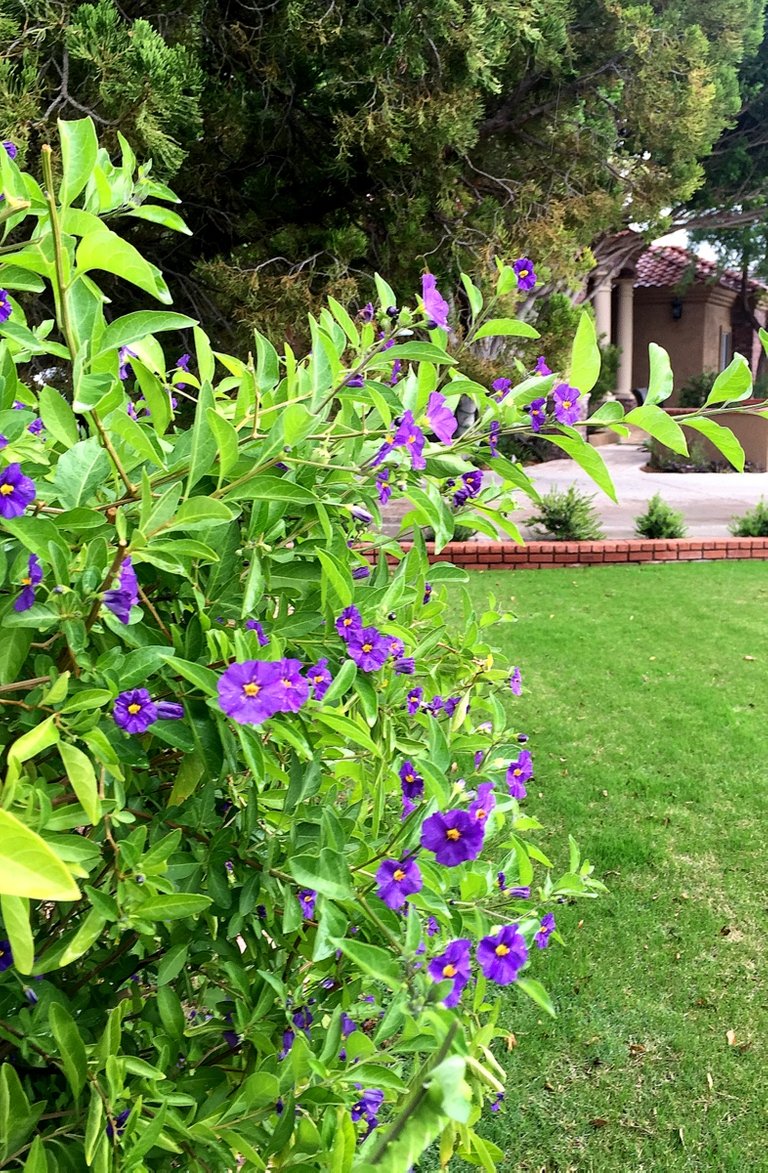
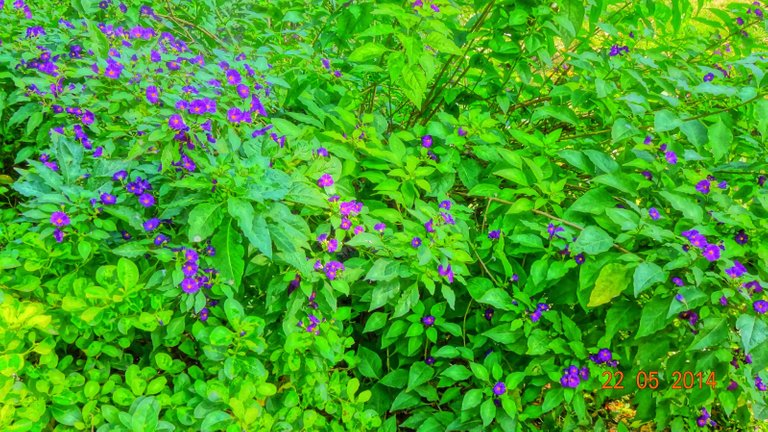.jpg)
Potato bush plant is grown outdoors in warm climates. In areas with cool winters, grow it as a potted plant that can be brought indoors when frost threatens. In cool areas, an abundance of small, blue flowers bloom in summer and fall. In frost-free areas, it blooms year round. The flowers are followed by bright red.
Potato bushes grow best if fertilized regularly. You can use a 2-inch layer of compost once or twice a year; a complete, balanced, slow-release fertilizer in spring and late summer; or a liquid fertilizer once every month or two. Compost helps the soil manage water efficiently.
Blue potato bush needs a sunny location and a frost-free climate. The plant prefers an organically rich soil that is constantly moist, but well-drained. Achieve the right balance of moisture by watering the plant slowly and deeply when the surface feels dry. Apply a layer of mulch over the soil to slow water evaporation. If the soil drains too quickly, work in some organic material,
(SOURCE)https://www.gardeningknowhow.com/ornamental/shrubs/potato-bush/potato-bush-information.htm.
very beautiful name. Seeing your second photo I understood why he is called a blue climber.
@ctrl-alt-nwo, After watching this picture i want to say one thing and that is, for sure these pictures throwing one most beautiful aspect.
And first impression is breathtaking because it's clearly showcasing one thing and that is, two unique colours are staying at one place.
As soon as I've watched these pictures, the Purple colour of flowers is throwing the eye-catching and Artful essence.
I want to appreciate your work because, you always share Simplistic Natural pictures but i always believe that aspects which we think as simple, holds the more value and essence.
Wishing you an great day and stay blessed. 🙂
They say that you should stick to the KISS principle !
Ha ha. 🙂
Native to Argentina, Bolivia, Brazil, and Paraguay, the blue potato bush is cultivated all over the world for its beautiful deep purple-blue flowers. If you’ve ever seen it bloom, you won’t forget it.
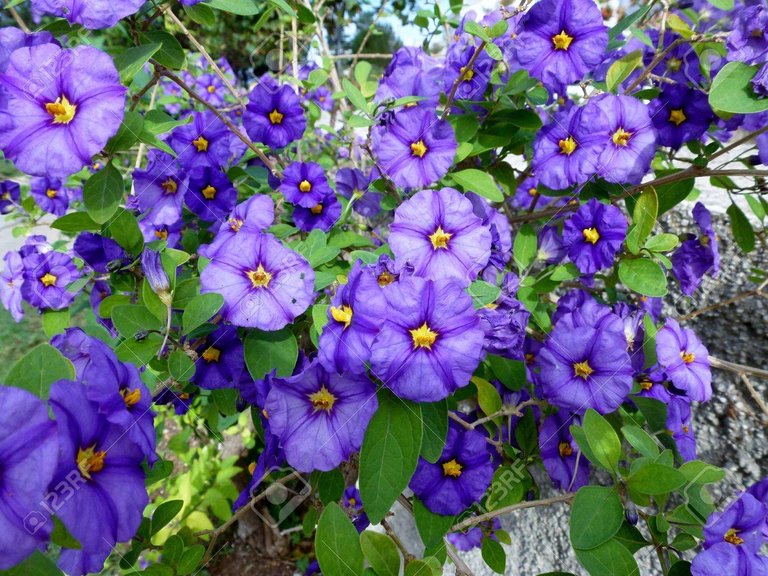
The Royal Horticultural Society gave Lycianthes rantonnetii their prestigious Award of Garden Merit in 2012.
Several cultivars have been produced with different colored foliage and blossoms. The cultivar Lycianthes rantonnetii 'White' has beautiful snow white flowers, while Lycianthes rantonnetii ‘Variegata’ has cream and grey-green leaves with blue flowers.
All varieties are sweetly scented and attract butterflies. If not pruned, this species will also produce berries which will attract a variety of birds.
Important note: All parts of this plant are poisonous if ingested, including the seeds and berries. Pet owners should monitor their dogs, in particular, to ensure they do not eat the berries or other parts of this shrub.
source
Brazilian potato tree (Solanum wrightii) is a cousin of Brugmansia. Another name is giant potato tree, blue potato tree, or blue giant potato. The flowering tree is not too high. the resulting flower looks sweet, and smells sweet. The blooms start white, then turn into pink, and then blue-brazilian-potato flowers.
Source:
https://www.google.co.id/url?sa=t&source=web&rct=j&url=http://bibitbunga.com/tanaman-brazilian-potato-tree/&ved=2ahUKEwiR8IK8wOLdAhVHLY8KHQQhAfwQFjAKegQIARAB&usg=AOvVaw02FVEIaE-cXPh5GkC4W4Rl
The species is named for Barthélémy Victor Rantonnet, a 19th-century French horticulturalist.

photo source
source
Lycianthes rantonnetii has previously been placed in Solanum, a huge genus which has recently been the subject of major investigation, with species being transferred to and from several different genera. There are many rare and little-known species whose true placement has yet to be determined
content source
Native to Argentina, Bolivia, Brazil, and Paraguay, the blue potato bush is cultivated all over the world for its beautiful deep purple-blue flowers. If you’ve ever seen it bloom, you won’t forget it. The Royal Horticultural Society gave Lycianthes rantonnetii their prestigious Award of Garden Merit in 2012.
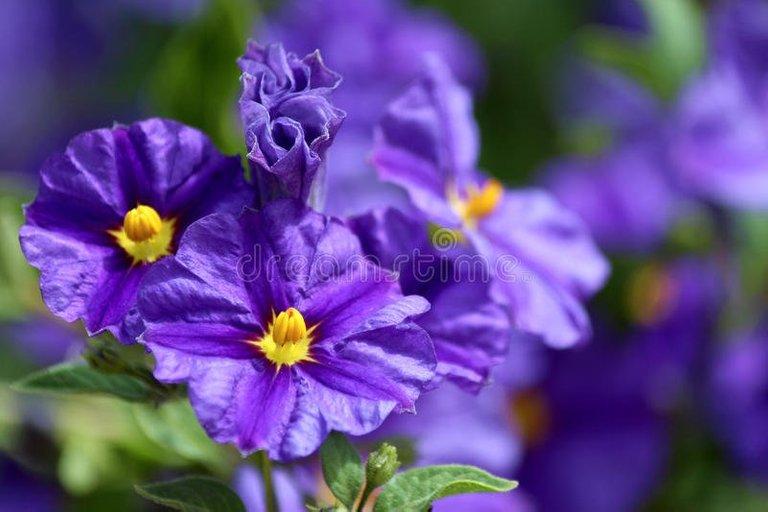.jpg)
source of photo
Several cultivars have been produced with different colored foliage and blossoms. The cultivar Lycianthes rantonnetii 'White' has beautiful snow white flowers, while Lycianthes rantonnetii ‘Variegata’ has cream and grey-green leaves with blue flowers. All varieties are sweetly scented and attract butterflies. If not pruned, this species will also produce berries which will attract a variety of birds.
source of photo
Named after the 19th-century French horticulturist, Barthélémy Victor Rantonnet, the botanical name for this plant is generally accepted as Lycianthes rantonnetii. It is also known as Solanum rantonnetii. The genus name is taken from the Greek word lykion which means ‘a thorny bush’, and anthos which means flower.
source of photo
Widely known by the common name of blue potato bush, this species is also called blue Lycianthes, Paraguay nightshade, and royal robe. The use of the common name of nightshade is not surprising because this plant was mistakenly thought to be one of the nightshade species, even though it is not.
source of article
So lovely flower! Widely known by the common name of blue potato bush, this species is also called blue Lycianthes, Paraguay nightshade, and royal robe. The use of the common name of nightshade is not surprising because this plant was mistakenly thought to be one of the nightshade species, even though it is not.
Named after the 19th-century French horticulturist, Barthélémy Victor Rantonnet, the botanical name for this plant is generally accepted as Lycianthes rantonnetii. It is also known as Solanum rantonnetii. The genus name is taken from the Greek word lykion which means ‘a thorny bush’, and anthos which means flower.

Source
Lycianthes rantonnetii is a species of flowering shrub in the family Solanaceae. Cultivated as ornamental the world over, you might deem it boring and decide to pass it over. But you'd be wrong.
The blue potato bush is one of about 150 species in the genus Lycianthes, which are found mostly in tropical regions of the Americas, with others in the Asia-Pacific region.
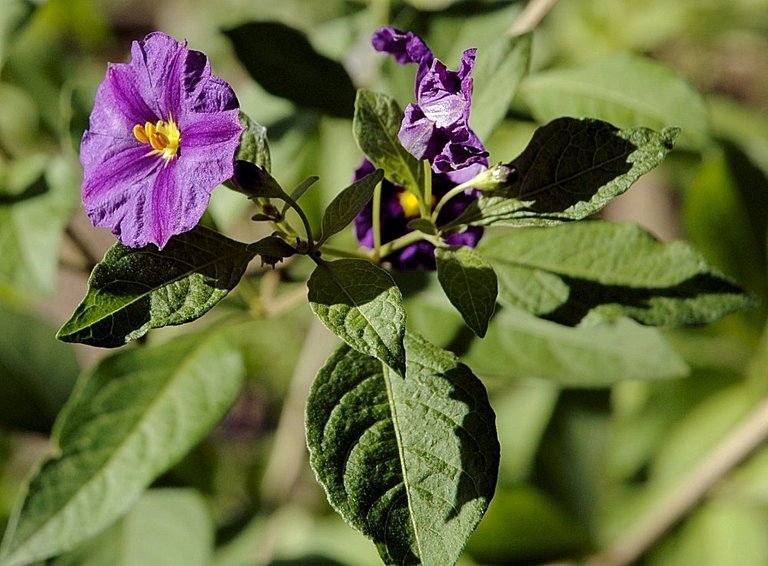
Source
Source
Growing to about 6 ft (1.8 m) tall and broad, it is a rounded evergreen shrub with a somewhat lax habit. A profusion of trumpet-shaped, bright blue-purple flowers with a prominent yellow eye appear in summer, followed by red berries. It is widely cultivated and may be hardy in mild or coastal areas. Alternatively it can be grown in a container and brought under cover in winter. It requires a sheltered location in full sun. Though related to food plants like the potato and tomato, all parts of the plant are considered toxic to humans.
Source
Members of the family Solanaceae amaze with their diversity. They are almost all poisonous, I mean leaves, stalks. some species have poisonous berries in any form, in some species the berries are only poisonous in the immature stage. They are probably united by one thing, they are all curly. I had the most interesting experience when I grew sweet potatoes - sweet potatoes, in terms of Moldova. Very interesting plants. Flowers are very similar to these. Even different varieties of potatoes have different flowers, but there is something that unites them, the Colorado potato beetle loves them all))) Wonderful article and photo.
Try some Neem oil, that will fix those beetles.
Lycianthes rantonnetii, the blue potato bush or Paraguay nightshade is a species of flowering plant in the nightshade family Solanaceae, native to South America.
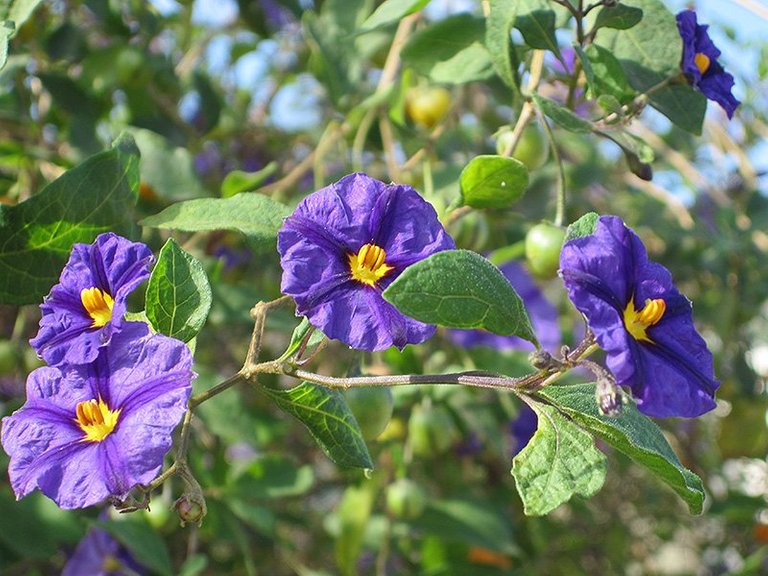
Source
Source
Source
Growing to about 6 ft (1.8 m) tall and broad, it is a rounded evergreen shrub with a somewhat lax habit. A profusion of trumpet-shaped, bright blue-purple flowers with a prominent yellow eye appear in summer, followed by red berries. It is widely cultivated and may be hardy in mild or coastal areas. Alternatively it can be grown in a container and brought under cover in winter. It requires a sheltered location in full sun. Though related to food plants like the potato and tomato, all parts of the plant are considered toxic to humans. Source
L. rantonnetii is a lax, evergreen shrub producing clusters of lightly fragrant, purple-blue, funnel-shaped flowers in summer and autumn.

source
source
May survive as a wall-shrub in very mild areas, or grow as a standard in a pot and take under cover for winter. Otherwise grow in a cool greenhouse or conservatory with shade from the brightest sun and moderate humidity. Plants will require support
source
Nice to know about this plant quite a complicated name but very simple and great in looks amazing to see that :)
Lycianthes rantonnetii, the blue potato bush or Paraguay nightshade[1] is a species of flowering plant in the nightshade family Solanaceae, native to South America.
Growing to about 6 ft (1.8 m) tall and broad, it is a rounded evergreen shrub with a somewhat lax habit. A profusion of trumpet-shaped, bright blue-purple flowers with a prominent yellow eye appear in summer, followed by red berries.
It is widely cultivated and may be hardy in mild or coastal areas. Alternatively it can be grown in a container and brought under cover in winter. It requires a sheltered location in full sun.[3] Though related to food plants like the potato and tomato, all parts of the plant are considered toxic to humans.
It has been given the Royal Horticultural Society’s Award of Garden Merit.
The species is named for Barthélémy Victor Rantonnet, a 19th-century French horticulturalist.[5]
Lycianthes rantonnetii has previously been placed in Solanum, a huge genus which has recently been the subject of major investigation, with species being transferred to and from several different genera. There are many rare and little-known species whose true placement has yet to be determined.
source
Beautiful photos of Lycianthes rantonnetii
Pretty cute inflorescences, @ctrl-alt-nwo
source
Family:
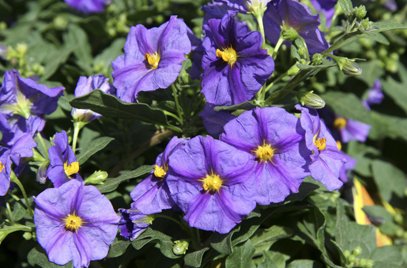
Solanaceae
Details:
L. rantonnetii is a lax, evergreen shrub producing clusters of lightly fragrant, purple-blue, funnel-shaped flowers in summer and autumn.
Cultivation:
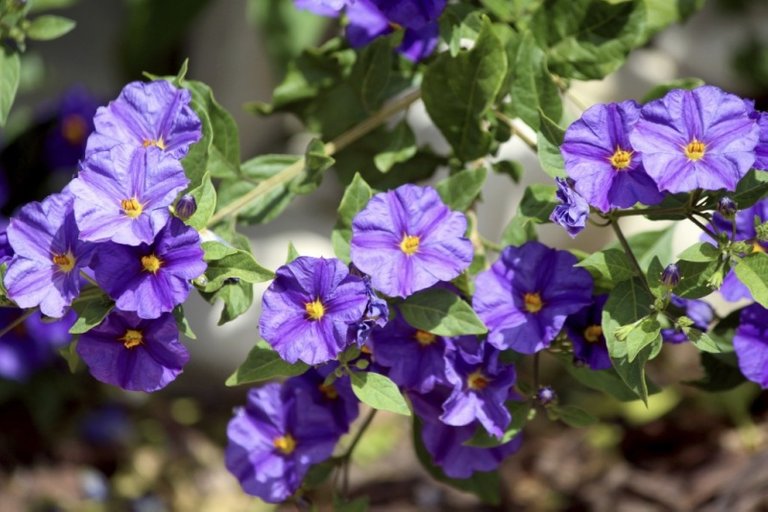
May survive as a wall-shrub in very mild areas, or grow as a standard in a pot and take under cover for winter. Otherwise grow in a cool greenhouse or conservatory with shade from the brightest sun and moderate humidity. Plants will require support
Propagation:
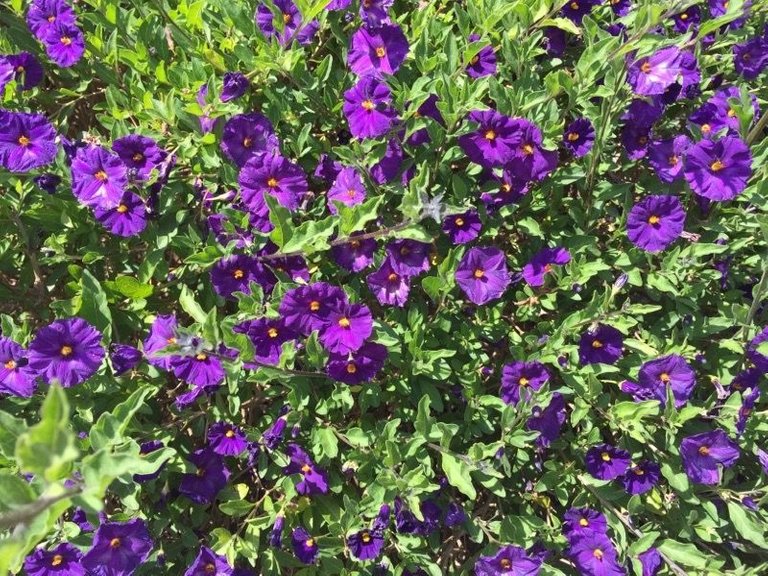
Propagate by seed, or semi-ripe cuttings taken in summer or early autumn and rooted with gentle bottom heat
How to care
Pruning
Pruning group 9 if freestanding or pruning group 12 as a wall shrub
Pests

Prone to aphids and glasshouse red spider mites whilst under glass
Diseases
Prone to grey moulds under glass.
Content Source
Poisonous to animals also?
Birds probably come and eat the berries, but i would not feed it to pets.
I do liked the yellow center of it, made t look even more beautiful.
While the unique pattern of it in the form of starfish was indeed cool as well.
So lovely flower! Widely known by the common name of blue potato bush, this species is also called blue Lycianthes, Paraguay nightshade, and royal robe. The use of the common name of nightshade is not surprising because this plant was mistakenly thought to be one of the nightshade species, even though it is not.
Named after the 19th-century French horticulturist, Barthélémy Victor Rantonnet, the botanical name for this plant is generally accepted as Lycianthes rantonnetii. It is also known as Solanum rantonnetii. The genus name is taken from the Greek word lykion which means ‘a thorny bush’, and anthos which means flower.

Source
Lycianthes rantonnetii is a species of flowering shrub in the family Solanaceae. Cultivated as ornamental the world over, you might deem it boring and decide to pass it over. But you'd be wrong.
The blue potato bush is one of about 150 species in the genus Lycianthes, which are found mostly in tropical regions of the Americas, with others in the Asia-Pacific region.

Source
Source
Growing to about 6 ft (1.8 m) tall and broad, it is a rounded evergreen shrub with a somewhat lax habit. A profusion of trumpet-shaped, bright blue-purple flowers with a prominent yellow eye appear in summer, followed by red berries. It is widely cultivated and may be hardy in mild or coastal areas. Alternatively it can be grown in a container and brought under cover in winter. It requires a sheltered location in full sun. Though related to food plants like the potato and tomato, all parts of the plant are considered toxic to humans.
Source
Native to Argentina and Paraguay, Blue Solanum Shrub is a beautiful ever-blooming shrub, clutivated for its blue-purple flowers. It is a much-branched, fast growing evergreen shrub that grows up to 6 feet tall and wide. It produces masses of deep purple flowers with yellow centers. Flowering is most pronounced in summer.
This shrub has evergreen leaves that are alternate, simple, entire, oval to lanceolate. They are almost glabrous on the upper side, and hairy on the underside, with slightly wavy margins.
They are up to 4 in long. Flowers are .5-1 in (1.25-2.5 cm) in diameter. They are grouped at the leaf axils. Fruits are not edible. They are red and ovoïd small berries.
source
beautiful purple flowers friend!
Blue Potato
Native to Argentina, Bolivia, Brazil, and Paraguay, the blue potato bush is cultivated all over the world for its beautiful deep purple-blue flowers. If you’ve ever seen it bloom, you won’t forget it. The Royal Horticultural Society gave Lycianthes rantonnetii their prestigious Award of Garden Merit in 2012.

Several cultivars have been produced with different colored foliage and blossoms. The cultivar Lycianthes rantonnetii 'White' has beautiful snow white flowers, while Lycianthes rantonnetii ‘Variegata’ has cream and grey-green leaves with blue flowers. All varieties are sweetly scented and attract butterflies. If not pruned, this species will also produce berries which will attract a variety of birds.
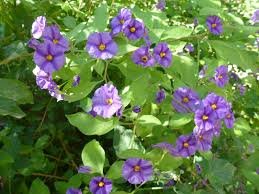

I learned a lot of interesting things about this plant. The potato tree is a perennial shrub - it means that you will see the plant return year after year to bring color into your garden from summer to autumn. After the fragrant flowers disappear, the plant will produce attractive red berries. Blue potato bush is cultivated all over the world for its beautiful dark purple blue flowers. If you have ever seen its bloom, you will not forget it. Important note: All parts of this plant are poisonous if ingested, including seeds and berries. Pet owners should watch out for their dogs, in particular, so that they do not eat berries or other parts of this bush.
https://ru.nctodo.com/blue-potato-bush-growing-profile
OMG! It's a very beautiful flower and very pleasant to enjoy seeing collections that are extraordinary and very amazing. Hopefully a beautiful and pleasant day is always @ctrl-alt-nwo!❤
Unfortunately, i could not see any potato in it
Posted using Partiko Android
Lycianthes rantonnetii, the blue potato bush or Paraguay nightshade is a species of flowering plant in the nightshade family Solanaceae, native to South America.It Grows to about 6 ft (1.8 m) tall and broad, it is a rounded evergreen shrub with a somewhat lax habit. A profusion of trumpet-shaped, bright blue-purple flowers with a prominent yellow eye appear in summer, followed by red berries. It requires a sheltered location in full sun.Though related to food plants like the potato and tomato, all parts of the plant are considered toxic to humans.

Thanks for the comment, but you must quote the SOURCE for the photo unless it is your own.
Sure sir .
Very good flower plant for garden . Flowers color is very pretty. That's why this plant is looking unique . Thanks
Firstly I love flowers . Secondly flowers are best beauty of nature I think. These flower color combination is very good.Nice sharing dear.
I like purple color very much. This is my favourite one . Nice flowers . Thanks
The plant may be poisonous but the flowers are looking absolutely beautiful. Thank you.
very beautiful flower friend
Blue potato bush
Other common names
blue potato bush
Synonyms
Solanum rantonnetii
Family
Solanaceae
Details
L. rantonnetii is a lax, evergreen shrub producing clusters of lightly fragrant, purple-blue, funnel-shaped flowers in summer and autumn. These are followed by red berries.
https://www.rhs.org.uk/Plants/57749/i-Lycianthes-rantonnetii-i/Details